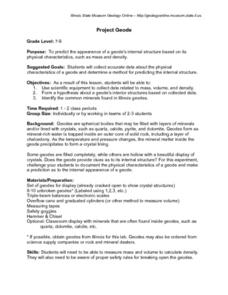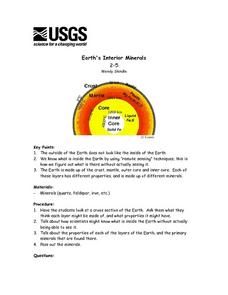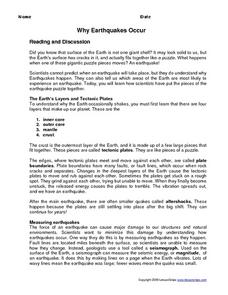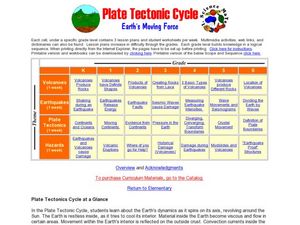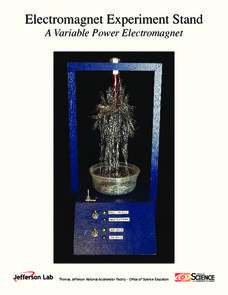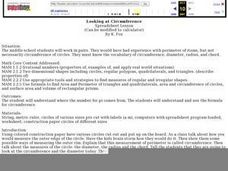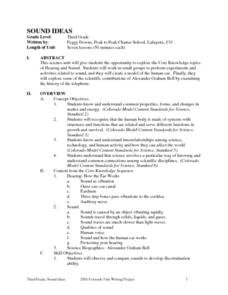Curated OER
Seafloor Spreading
In this seafloor spreading worksheet, students use 12 given terms to complete sentences about the layers of the Earth and the components of the layers of the Earth.
Curated OER
Personal Written Response Activity
Students complete a final written project. In this personal response lesson, students respond in a creative way to one of the issues presented in the unit. Students may choose to create a series of postcards from a natural...
Curated OER
Earth Science: Layers of the Earth
In this earth science activity, students match vocabulary words to their definition. Students identify words dealing with the layers of the earth. They match 13 words.
Curated OER
Words in the News Hopes and Fears for Shuttle Discovery
Middle schoolers participate in vocabulary building activities including worksheets before reading an online article. They write a space travel diary of their first visit to outer space in a journal entry.
Curated OER
King Lear's Storm
Students read speeches from King Lear. They examine the sppeach for meaning by paraphrasing and defining words. They read aloud with "storm" in their voices. Groups perform their speech and class discusses it in terms of inner vs. outer...
NOAA
I Didn’t Do It…Did I?: Make Your Own Greenhouse Effect
How do greenhouse gases affect the climate on Earth? Pupils explore the concept by first building their own apparatuses to model the greenhouse effect. Then, they record data to measure temperature change and determine...
Curated OER
Project Geode
Young geologists attempt to predict the appearnace of a geode's internal structure based on how it looks from the outside, its mass, and its physical characteristics. In this geologly lesson, learners use scientific equipment to collect...
Curated OER
Volcanoes: Windows Into The Earth
Students investigate the concepts related to volcanoes and focus upon Mt. St. Helens. They define the difference between an active and dormant volcano. They conduct research using a variety of resources. The information is used in order...
Curated OER
Entering the Twilight Zone
Students describe major features of cold-seep communities and the process of chemosynthesis as it relates to organisms in each habitat. In this deep-sea habitats lesson, students study the categorization of ocean habitats...
Curated OER
Earth's Interior Minerals
Students identify the layers of the Earth. They discover the properties and minerals in each layer. They answer questions about the minerals found to end the lesson.
Curated OER
The Earth
When students embark on an exploration of the Earth and rock formations, this resource could be used as a way to introduce or review key concepts. Students could use this presentation as a way to review information independently at a...
Curated OER
Urbanization As Seen Through Late 19c - Early 20c Architecture
Incorporating the cultures, architecture, and ethnic populations of several American cities (namely Chicago and New York), this presentation displays vivid photographs of buildings and people in 19th - 20th century urban America. The...
Curated OER
Planet Earth in Cross Section
Students will examine the layers of the Earth. In this geology activity, students create a scale model of the Earth's interior using cash register tape. They will determine the percentage of error in the scale compared to the actual size...
Curated OER
Plate Tectonics Review
In this plate tectonics worksheet, students review concepts such as the types of plate boundaries, the concept of continental drift, sea-floor spreading, earthquakes, and plate tectonics. They match 30 terms with their definitions.
Curated OER
Why Earthquakes Occur
In this earthquake activity, students learn about why earthquakes occur. After reading the information, they answer the 12 questions in the packet. The answers are on the last page.
Curated OER
Plate Tectonic Cycle
Students explore the Earth's movements by completing worksheets. For this plate tectonics lesson, students define such natural disasters as volcanoes, earthquakes, tsunamis and mudslides and discuss their connections to plate tectonics....
Curated OER
once and future MOON
Beyond the phases of the moon, this comprehensive lesson plan covers geologic history and geology. Amateur astronauts examine photos of the lunar landscape, experiment with the creation of craters, and delve into information about the...
Curated OER
A Model of the Sea-floor
Students create a paper model to illustrate sea-floor spreading.
Oceanic Research Group
Heat Transfer and Cooling
Astronauts train underwater to simulate the change in gravity. An out-of-this-world unit includes three hands-on activities, one teacher demonstration, and a discussion related to some of the challenges astronauts face. Scholars apply...
US Department of Energy
Electromagnet Experiment Stand: A Variable Power Electromagnet
Electromagnets come in both large and small scales—from big machinery in scrap yards to hard disk drives. Here's a resource that provides directions for building a variable electromagnet on a stand. Scholars then experiment with the...
Curated OER
Looking at Circumference
Students understand where the number for pi comes from. They understand and use the formula for circumference. Students measure the circles given out and the diameters of those circles and record the results on their worksheet.
American Museum of Natural History
Create a Compass
Historically, humans have used many methods of finding due north. Using a hands-on activity, learners create their own compasses. They then test their compasses in their neighborhood or to assist with stargazing.
Howard Hughes Medical Institute
Virus Explorer
Most pupils know about the flu, HIV, and other viruses, but they don't know what each actually looks like. This interactive shows their relative size, structure, and allows for comparisons. It stresses the similarities and differences...
Curated OER
Sound Ideas
Complete a unit of lessons on hearing and sound. Learners conduct sound experiments, research the history of the telephone and scientific contributions of Alexander Graham Bell, and create a model of the human ear.






